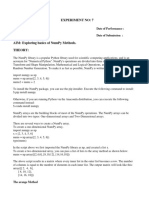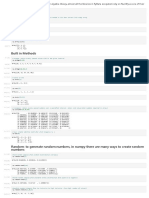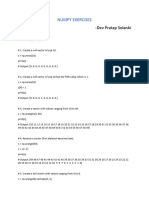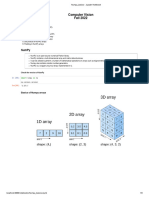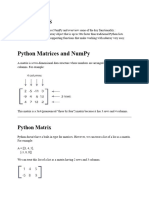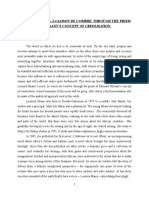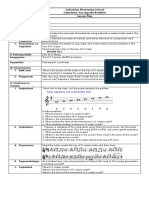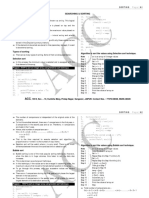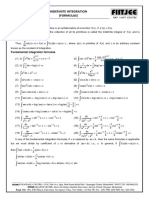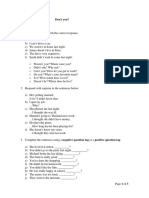NumPy Exercises
Import NumPy as np
In [ ]: import numpy as np
Create an array of 10 zeros
In [ ]: np.zeros(10)
Out[ ]: array([ 0., 0., 0., 0., 0., 0., 0., 0., 0., 0.])
Create an array of 10 ones
In [ ]: np.ones(10)
Out[ ]: array([ 1., 1., 1., 1., 1., 1., 1., 1., 1., 1.])
Create an array of 10 fives
In [ ]: np.ones(10) * 5
Out[ ]: array([ 5., 5., 5., 5., 5., 5., 5., 5., 5., 5.])
Create an array of the integers from 10 to 50
In [ ]: np.arange(10,51)
Out[ ]: array([10, 11, 12, 13, 14, 15, 16, 17, 18, 19, 20, 21, 22, 23, 24, 25, 26,
27, 28, 29, 30, 31, 32, 33, 34, 35, 36, 37, 38, 39, 40, 41, 42, 43,
44, 45, 46, 47, 48, 49, 50])
Create an array of all the even integers from 10 to 50
In [ ]: np.arange(10,51,2)
Out[ ]: array([10, 12, 14, 16, 18, 20, 22, 24, 26, 28, 30, 32, 34, 36, 38, 40, 42,
44, 46, 48, 50])
� Create a 3x3 matrix with values ranging from 0 to 8
In [ ]: np.arange(9).reshape(3,3)
Out[ ]: array([[0, 1, 2],
[3, 4, 5],
[6, 7, 8]])
Create a 3x3 identity matrix
In [ ]: np.eye(3)
Out[ ]: array([[ 1., 0., 0.],
[ 0., 1., 0.],
[ 0., 0., 1.]])
Use NumPy to generate a random number between 0 and 1
In [ ]: np.random.rand(1)
Out[ ]: array([ 0.42829726])
Use NumPy to generate an array of 25 random numbers sampled from a standard normal distribution
In [ ]: np.random.randn(25)
Out[ ]: array([ 1.32031013, 1.6798602 , -0.42985892, -1.53116655, 0.85753232,
0.87339938, 0.35668636, -1.47491157, 0.15349697, 0.99530727,
-0.94865451, -1.69174783, 1.57525349, -0.70615234, 0.10991879,
-0.49478947, 1.08279872, 0.76488333, -2.3039931 , 0.35401124,
-0.45454399, -0.64754649, -0.29391671, 0.02339861, 0.38272124])
Create the following matrix:
In [ ]: np.arange(1,101).reshape(10,10) / 100
Out[ ]: array([[ 0.01, 0.02, 0.03, 0.04, 0.05, 0.06, 0.07, 0.08, 0.09, 0.1 ],
[ 0.11, 0.12, 0.13, 0.14, 0.15, 0.16, 0.17, 0.18, 0.19, 0.2 ],
[ 0.21, 0.22, 0.23, 0.24, 0.25, 0.26, 0.27, 0.28, 0.29, 0.3 ],
[ 0.31, 0.32, 0.33, 0.34, 0.35, 0.36, 0.37, 0.38, 0.39, 0.4 ],
[ 0.41, 0.42, 0.43, 0.44, 0.45, 0.46, 0.47, 0.48, 0.49, 0.5 ],
[ 0.51, 0.52, 0.53, 0.54, 0.55, 0.56, 0.57, 0.58, 0.59, 0.6 ],
[ 0.61, 0.62, 0.63, 0.64, 0.65, 0.66, 0.67, 0.68, 0.69, 0.7 ],
[ 0.71, 0.72, 0.73, 0.74, 0.75, 0.76, 0.77, 0.78, 0.79, 0.8 ],
� [ 0.81, 0.82, 0.83, 0.84, 0.85, 0.86, 0.87, 0.88, 0.89, 0.9 ],
[ 0.91, 0.92, 0.93, 0.94, 0.95, 0.96, 0.97, 0.98, 0.99, 1. ]])
Create an array of 20 linearly spaced points between 0 and 1:
In [ ]: np.linspace(0,1,20)
Out[ ]: array([ 0. , 0.05263158, 0.10526316, 0.15789474, 0.21052632,
0.26315789, 0.31578947, 0.36842105, 0.42105263, 0.47368421,
0.52631579, 0.57894737, 0.63157895, 0.68421053, 0.73684211,
0.78947368, 0.84210526, 0.89473684, 0.94736842, 1. ])
Numpy Indexing and Selection
Now you will be given a few matrices, and be asked to replicate the resulting matrix outputs:
In [ ]: mat = np.arange(1,26).reshape(5,5)
mat
Out[ ]: array([[ 1, 2, 3, 4, 5],
[ 6, 7, 8, 9, 10],
[11, 12, 13, 14, 15],
[16, 17, 18, 19, 20],
[21, 22, 23, 24, 25]])
In [ ]: # WRITE CODE HERE THAT REPRODUCES THE OUTPUT OF THE CELL BELOW
# BE CAREFUL NOT TO RUN THE CELL BELOW, OTHERWISE YOU WON'T
# BE ABLE TO SEE THE OUTPUT ANY MORE
In [ ]: mat[2:,1:]
Out[ ]: array([[12, 13, 14, 15],
[17, 18, 19, 20],
[22, 23, 24, 25]])
In [ ]: # WRITE CODE HERE THAT REPRODUCES THE OUTPUT OF THE CELL BELOW
# BE CAREFUL NOT TO RUN THE CELL BELOW, OTHERWISE YOU WON'T
# BE ABLE TO SEE THE OUTPUT ANY MORE
In [ ]: mat[3,4]
Out[ ]: 20
�In [ ]: # WRITE CODE HERE THAT REPRODUCES THE OUTPUT OF THE CELL BELOW
# BE CAREFUL NOT TO RUN THE CELL BELOW, OTHERWISE YOU WON'T
# BE ABLE TO SEE THE OUTPUT ANY MORE
In [ ]: mat[:3,1:2]
Out[ ]: array([[ 2],
[ 7],
[12]])
In [ ]: # WRITE CODE HERE THAT REPRODUCES THE OUTPUT OF THE CELL BELOW
# BE CAREFUL NOT TO RUN THE CELL BELOW, OTHERWISE YOU WON'T
# BE ABLE TO SEE THE OUTPUT ANY MORE
In [ ]: mat[4,:]
Out[ ]: array([21, 22, 23, 24, 25])
In [ ]: # WRITE CODE HERE THAT REPRODUCES THE OUTPUT OF THE CELL BELOW
# BE CAREFUL NOT TO RUN THE CELL BELOW, OTHERWISE YOU WON'T
# BE ABLE TO SEE THE OUTPUT ANY MORE
In [ ]: mat[3:5,:]
Out[ ]: array([[16, 17, 18, 19, 20],
[21, 22, 23, 24, 25]])
Now do the following
Get the sum of all the values in mat
In [ ]: mat.sum()
Out[ ]: 325
Get the standard deviation of the values in mat
In [ ]: mat.std()
Out[ ]: 7.2111025509279782
� Get the sum of all the columns in mat
In [ ]: mat.sum(axis=0)
Out[ ]: array([55, 60, 65, 70, 75])
Great Job!



